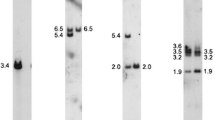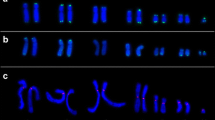Abstract
Fluorescencein situ hybridization (FISH) of microlibraries established from distinct chromosome subregions can test the evolutionary conservation of chromosome bands as well as chromosomal rearrangements that occurred during primate evolution and will help to clarify phylogenetic relationships. We used a DNA library established by microdissection and microcloning from the entire long arm of human chromosome 2 for fluorescencein situ hybridization and comparative mapping of the chromosomes of human, great apes (Pan troglodytes, Pan paniscus, Gorilla gorilla, Pongo pygmaeus) and Old World monkeys (Macaca fuscata andCercopithecus aethiops). Inversions were found in the pericentric region of the primate chromosome 2p homologs in great apes, and the hybridization pattern demonstrates the known phylogenetically derived telomere fusion in the line that leads to human chromosome 2. The hybridization of the 2q microlibrary to chromosomes of Old World monkeys gave a different pattern from that in the gorilla and the orang-utan, but a pattern similar to that of chimpanzees. This suggests convergence of chromosomal rearrangements in different phylogenetic lines.
Similar content being viewed by others
References
Arnold N, Wienberg J, Ermert K, Zachau H-G Comparative mapping of human and great ape chromosomes by in situ hybridization of DNA probes derived from the V-kappa immunoglobulin genes.Genomics, submitted.
Avarello R, Pedicini A, Caiulo A, Zuffardi O, Fraccaro M (1992) Evidence for an ancestral alphoid domain on the long arm of human chromosome 2.Hum Genet 89 247–249.
Baldini A, Ried T, Shridhar Vet al. (1993) An alphoid DNA sequence conserved in all human and great ape chromosomes: evidence for ancient centromeric sequences at human chromosomal regions 2q21 and 9q13.Hum Genet 90: 577–583.
Boer de LEM, Seuánez HN (1982) The chromosomes of the orangutan and their relevance to the conservation of the spezies. In: de Boer LEM, ed.The Orangutan. Its Biology and Conservation. The Hague: Junk, pp 135–170.
Cremer T, Lichter P, Borden J, Ward DC, Manuelidis L (1988) Detection of chromosome aberrations in metaphase and interphase tumour cells by in situ hybridization using chromosome specific library probes.Hum Genet 80 235–246.
Djalali M, Steinbach P, Bullerdiek J, Holmes-Siedle M, Verschraegen-Spae MR, Smith A (1986) The significance of pericentric inversions of chromosome 2.Hum Genet 72 32–36.
Dutrillaux B (1979) Chromosomal evolution in primates. Tentative phylogeny fromMicrocebus murinus (prosimian to man.Hum Genet 48 251–314.
Gelman-Kohan Z, Rosensaft J, Nisani B-C, Chemke J (1993) Homozygosity for inversion (2) (p12q14).Hum Genet 92 427.
Ijdo JW, Baldini A, Ward DC, Reeders ST, Wells RA (1991) Origin of human chromosome 2: an ancestral telomere—telomere fusion.Proc Natl Acad Sci USA 88 9051–9055.
Jauch A, Wienberg J, Stanyon Ret al. (1992) Reconstruction of genomic rearrangements in great apes and gibbons by chromosome painting.Proc Natl Acad Sci USA 89 8611–8615.
Klever M, Grond-Ginsbach C, Scherthan H, Schroeder-Kurth T (1991) Chromosomal in situ suppression hybridization after Giemsa banding.Hum Genet 86 484–486.
Lengauer C, Lüdecke H-J, Wienberg J, Cremer T, Horsthemke B (1991a) Comparative chromosome band mapping in primates byin situ suppression hybridization of band specific DNA microlibraries.Hum Evol 6 67–71.
Lengauer C, Eckelt A, Weith Aet al. (1991b) Painting of defined chromosomal regions by in situ suppression hybridization of libraries from laser-microdissected chromosomes.Cytogenet Cell Genet 56 27–30.
Lengauer C, Riethman HC, Speicher Met al. (1992) Metaphase and interphase cytogenetics with Alu-PCR amplified YAC clones containing the BCR-gene and the protooncogenes c-raf-1, c-fms, c-erbB-2.Cancer Res 52 2590–2596.
Lichter P, Cremer T, Borden J, Manuelidis L, Ward DC (1988) Delineation of individual human chromosomes in metaphase and interphase cells byin situ suppression hybridization using recombinant DNA libraries.Hum Genet 80 224–234.
Lüdecke H-J, Senger G, Claussen U, Horsthemke B (1989) Cloning defined regions of the human genome by microdissection of banded chromosomes and enzymatic amplification.Nature 338 348–350.
Pinkel D, Landegent J, Collins Cet al. (1988) Fluorescence in situ hybridization with human chromosome specific libraries: detection of trisomy 21 and translocation of chromosome 4.Proc Natl Acad Sci USA 85 9138–9142.
Ried T, Lengauer C, Cremer Tet al. (1991) Specific metaphase and interphase detection of the breakpoint region in 8q24 of Burkitt lymphoma cells by triple colour fluorescence in situ hybridization.Genes, Chromosomes and Cancer 4 1–6.
Stanyon R, Chiarelli B (1983) Mode and tempo in primate chromosome evolution: implications for hylobatid phylogeny.J Hum Evol 12 305–315.
Stanyon R, Sineo L, Chiarelli B, Camperio-Ciani A, Haimoff AR, Mootnick EH (1987) Banded karyotypes of the 44-chromosome Gibbons.Folia Primatol 48 56–64.
Stanyon R, Arnold N, Koehler U, Bigoni F, Wienberg J (1994) Chromosomal painting shows that ‘marked chromosomes’ in lesser apes and Old World monkeys are not homologous and evolved by convergence.Cytogenet Cell Genet, in press.
Trautmann U, Leuteritz G, Senger G, Claussen U, Ballhausen WG (1991) Detection of APC region-specific signals by nonisotopic chromosomalin situ suppression (CISS)—hybridization using a microdissection library as a probe.Hum Genet 87 495–497.
Wells RA, Gemino GG, Krishna S, Buckle VJ, Reeders ST (1990) Telomere-related sequences at interstitial sites in the human genome.Genomics 8 699–704.
Wienberg J, Jauch A, Stanyon R, Cremer T (1990) Molecular cytotaxonomy of primates by chromosomalin situ suppression hybridization.Genomics 8 347–350.
Wienberg J, Stanyon R, Jauch A, Cremer T (1992) Homologies in human andMaccaca fuscata chromosomes revealed byin situ suppression hybridization with human chromosome specific DNA libraries.Chromosoma 101 265–270.
Yunis JJ, Prakash O 1982 The origin of man: a chromosomal pictorial legacy.Science 215 1525–1529.
Author information
Authors and Affiliations
Rights and permissions
About this article
Cite this article
Wienberg, J., Jauch, A., Lüdecke, H.J. et al. The origin of human chromosome 2 analyzed by comparative chromosome mapping with a DNA microlibrary. Chromosome Res 2, 405–410 (1994). https://doi.org/10.1007/BF01552800
Received:
Revised:
Accepted:
Issue Date:
DOI: https://doi.org/10.1007/BF01552800




